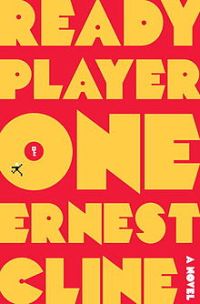 Okay, let’s say you’re a child of the 1980s, and like a lot of people who were teens during that unprecedented explosion of pop culture you’re thoroughly steeped in the lore of 80s American movies, television shows, video games, music, and toys. NOW, imagine that all that trivia is key –almost literally– to proving not only that you weren’t wasting your youth, but also to defeating evil, getting the girl, and acquiring massive riches. That’s pretty much the nerd fantasy behind Ready Player One by Ernest Cline.
Okay, let’s say you’re a child of the 1980s, and like a lot of people who were teens during that unprecedented explosion of pop culture you’re thoroughly steeped in the lore of 80s American movies, television shows, video games, music, and toys. NOW, imagine that all that trivia is key –almost literally– to proving not only that you weren’t wasting your youth, but also to defeating evil, getting the girl, and acquiring massive riches. That’s pretty much the nerd fantasy behind Ready Player One by Ernest Cline.
The setup for this dystopian future science fiction novel is that James Haliday was a game designer and fan of the 80s who was equal parts Howard Hughes, Richard Garriot, and batcrap crazy. He was also the pro generator of “The OASIS,” a virtual reality game into which most of the world has retreated in the face of global calamity. Right before dying, Haliday announced a massive quest within his creation, challenging players to find a series of secret challenges within the virtual universe. The winner gets control of the OASIS as well as several billion dollars. Enter our hero and narrator Wade Watts, a.k.a., “Parzival,” a destitute youth who educates himself on everything the 1980s had to offer in order to find Haliday’s Egg before an amoral megacorporation can do the same and seize control of the virtual paradise.
The main hook in Ready Player One is how it revels in 80s pop culture. Absurdly enough, Parzival has to quote lines from Mathew Broderick movies and master multiple classic coin-op arcade games in order to find and beat each of Haliday’s challenges. In addition to these central plot points, conversations between fellow egg hunters (or “gunters” for short) are thick with similar references. Having come of age in the 80s I’m in the sweet spot for this kind of thing, and I recognized and appreciated almost every single reference. I smirked, for example, when one character snapped at another with “Tell the truth, Claire!” even when the author provided no other context. And I not only vividly remember the classic Atari 2600 game Adventure, but I had myself found the game’s easter egg after which Haliday’s entire hunt was patterned. So as a literary device, this stuff is fun if you’re the kind of person who will appreciate it. If you’re not, I’m not so sure.
On the downside, while the OASIS makes a vivid and flexible backdrop against which you can tell a story, Cline seems to over rely on it a bit in terms of plotting. Improbable plot devices constantly popped up in the form of overly convenient “artifacts” or super-items within the game, which highlighted cracks in Cline’s otherwise good plotting. Need a way to make the bad guys totally invincible for just long enough to make things dramatic? Artifact. Need a way to save the hero from certain death? Artifact. Want a humongous showdown between protagonist and antagonist? Two artifacts. It gets a little obvious at times, as does Perzival’s uncanny knack for possessing whatever area of obscure expertise needed to beat every challenge.
That said, Ready Player One is generally really readable and a lot of fun if you’re in the target audience. Things zip along quickly in the vein of a classic quest tale, which is exactly what the story is. Cline also taps into many themes that are relevant to anyone living nowadays –things like online privacy, escapism, commercialization of art, the value of offline friendships, obsessive fanboyism, and the like. These topics are handled pretty well in the context of the larger story, and Cline makes some insightful and interesting statements.
So I’d recommend Ready Player One if the gist of it sounds interesting to you. The “everything that was nerdy about your youth is actually awesome and totally key to domination of your opponents” plot is a bit eye rolling, as are the transparent plot devices, but it’s still fun and it’s neat to see someone throw references to things I loved as a kid like they were so much party confetti.
Published by